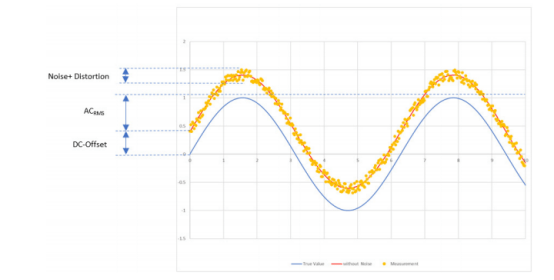abstract
This paper describes a method to determine the precision of a single sampling point. Using the general standard of the reference source table, the standardization program has different shortcomings, which will lead to problems, especially in the frequency range above 10 khz. Therefore, we propose a method to measure the precision of a single sampling point affected by a single factor, and combine the single factor into the signal precision. A practical application example is given for the Devitron TRION3-1820-MULTI measuring board.

introduce
The standard procedure for determining accuracy The simple way to determine accuracy is to use a reference measurement system with higher accuracy and compare measurement points one by one. Such a system must have a higher signal accuracy at least for bandwidth Interested, it must be synchronous. Another method is to apply an accurate input signal and compare the measured value with the assumed input value.
Both methods have problems:
1. Problems of reference measurement system:
Since the ACRMS accuracy of DEVCRO TRION3-18xx MULTI is very high at 100 kHz, it is not easy to find a reference system with high accuracy. Advanced reference source tables, such as FLUKE 5588A 8.5, use an 18 bit 5M sampling ADC. (Data source: 8588A Performance Specifications) In addition, in the digital mode, the performance indicators of the source tables are not satisfactory.
2. Problems when using reference sources:
Existing signal sources can provide the required accuracy of ACRMS, but the disadvantage is that the noise density is high, and the greater the signal strength, the greater the distortion value. On the other hand, low signal distortion signal sources usually have poor ACRMS and DC accuracy.
Determination method
Please read the signal accuracy measurement method of TRION3-18xx MULTI measuring board below. This method uses a stable low noise and low distortion signal generator to provide measurement signals. Use an 8.5 bit source meter (AGENT 3458A) with high ACRMS accuracy to measure the DC component of the loop ACRMS and the input signal. The signal accuracy of each component will be measured separately and combined into an accuracy value. These factors are:
ACCURACY OF ACRMS
Distortion error
DC accuracy
Input noise (peak to peak)
temperature drift
ACrms accuracy
This accuracy is determined by applying the sine signal and signal generator to TRION3-18xx-MULTI.
The input is measured in parallel with the reference source meter. The value of the reference source table (DMMRef) can be considered as true. By comparing the measured ACRMS value of the reference source table with the ACRMS value
ACRMS precision can be calculated by the value measured by TRION3-18xx MULTI (Signal). The measured signal must pass the TRION-18xx-MULTI input filter to calculate the ACRMS value. In this way, the filter will generate errors and automatically include the bandwidth error in the measurement.
Distortion error
The same settings must be used to measure distortion. Use appropriate mathematical functions to determine the distortion of the measured signal.
Suggestion: use ultra-low noise distortion function generator, such as Stanford Research DS360. Con connects the signal to the input channel and calculates the signal spectrum. Measure the amplitude and frequency domain frequency of the fundamental wave Uf [V] and the amplitude of the first five harmonics (UH1 [V], UH2 [V], UH3 [V], UH4 [V], UH5 [V]).
DC accuracy
To determine the DC accuracy of TRION3-18xx MULTI, shorten the input and measure the mean value (ShortAVG) representing the offset error. The value must be associated with the input range.
Input noise (peak to peak)
To determine the input noise of TRION3-18xx MULTI, short-circuit the input and measure the peak to peak (ShortP2P). This error also includes errors that occurred during digitization. Because it is wrong, it must be set according to the input range.
temperature drift
If the ambient temperature is different, the temperature drift of TRION3-18xx-MULTI must be considered
The temperature is 5 ° C higher than the room temperature. Because this test should be carried out at a constant room temperature without adding additional errors.



